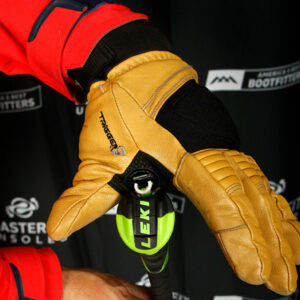
If you’re a new skier, you’ll be amazed by the variety of options for a seemingly simple stick with a grip on one end and a point on the other. But entry-level and occasional skiers need not complicate a ski pole purchase.
The Grip
The one part of the ski pole you feel most intimately about is the grip. Better grips are more ergonomically shaped and multi-material, for better feel. All grips include some form of strap, which comes in a variety of materials and configurations. The most common strap is an adjustable loop designed so your hand can rest against the strap when skiing. The most common mistake is grabbing the grip by putting your hand down through the loop; the strap only works for you if you put your hand up through it.
How to Size Poles
Sizing ski poles is simple. Turn the ski pole upside down, so the tip is pointed upwards. Grab the pole under the basket and put the handle on the ground just in front of your feet. If the size is right, your elbow will be at a right angle, with your forearm parallel with the ground.
Types of Shafts
As with grips, shafts come in a variety of materials and configurations. The most widely used material remains aluminum, although carbon and carbon-laced composites have their fans. You can even find ski poles made of bamboo, if that fits your retro style.
Aluminum comes in many grades, from an entry-level price around $40 to high-end styles that can cost as much as $250. The best aluminum shafts are lightweight and tapered for better balance.
The first carbon ski poles were dubbed “pencil poles,” for these highly flexible, narrow cylinders were about pencil-thick. Carbon’s edge over aluminum is its resistance to crimping when bent. Today carbon is available in several shaft styles.
Composite shafts mix carbon with cheaper materials to provide a sturdy, lightweight alternative to aluminum at less expensive prices. And if you really want bamboo, this all-natural solution comes with a long, padded and strapless grip.


